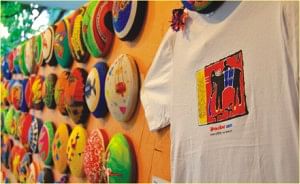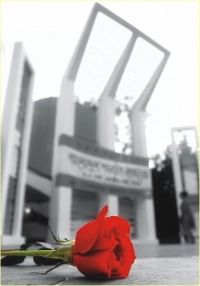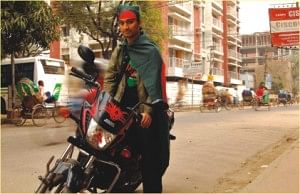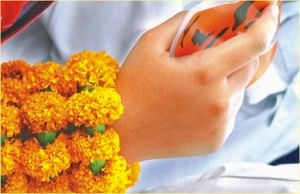
By Sabhanaz Rashid Diya
Photo: Sabhanaz Rashid Diya
As I sit here and tap my neurons to come up with words for this piece, the wind surges outside. The stormy tranquility of the weather reminds me of my most beloved childhood moment. The potent kaalbaiskakhi would brew even then; and with it, bring an air of refreshment and joy in our hearts. We would stand on the veranda of our grandfather's house in Rajshahi and wait for the sound of fresh mangoes falling on the grounds. With the slightest signal, we would rush out into the courtyard and start picking them up while the winds would wrestle with our small statures to blow us away. Being the youngest and tiniest, it was no common surprise that I would lag behind.

My nostalgic rendezvous was interrupted by the notification signal on my laptop screen. A new message popped up on the window. It was from my best friend, currently trapped in US. The message read:
“I miss Baishakh. I want to come home.”
The final speck of realization struck me. Baishakh was indeed knocking at our doors and it was time to embrace the red and white of a new year.
Although still another week away, the preparations for espousing the first day of the Bangla New Year have already begun. Cultural institutions, fashion labels, boutique shops, art students and literally anyone Bangali is now painting their lives in colours of Noboborsho. Bright shades of red, white, green, yellow and blue grace our clothes, streets and faces reminding us all over again how this is the most anticipated local festival in the calendar.
Charukola students are busy preparing their custom masks, T-shirts and miniature models of birds and colourful animals. The potteries are ornamented in the glosses of life, the dolls are on the verge of being draped in yellow, red and white fabric and the masks are undergoing their second coats of paint. The symphonies of Noboborsho beat at every corner of the art institution as the students gear up for their traditional grand rally across the Dhaka University campus.
Meanwhile, university students have started emblazoning their campuses in brightly ornamented fabrics and stroking alpona on the floors of their halls. The local craftsman and magician are grooming for the Noboborsho fairs with their mini ferris wheels and deck of cards. The fashion conscious crowd hovers from shop to shop, picking out their attires for celebrating Pahela Baishakh.
Soon, Dhaka will be embellished in every possible colour of life and its people will dance to the festivities of Noboborsho.
Come Baishakh, come
Come back into our lives…

By Zabir Hasan
Photo: Zabir Hasan
I don't know why they say dreams are black and white. Every time I dream I can see all the colours. That's why whenever I go out in the streets on “Pohela Bioshakh”, Falgun or any other national festival, they remind me of my dreams (not the nightmares of course).
Talking about the colours of festivals in our country, each of them has some distinctive shades and ambiances that create their independent entity. Colours that represent significance and verticality of any occasion are one of the unique attributes of Bangladeshi culture. With these colours we can share our joys, happiness and all the emotions with the world.
Pohela baishakh
The people of our country greet the Bangla New Year with the colours of red and white. Red strikes a chord with more cultures than many other colours because of its intensity, passion and invocation of an inherent physiological response. And White is the colour that represents purity, neutrality, serenity and youth.
“Pohela baishakh” is one of the most significant festivals in our life and the intensity of the celebration is growing every year. The most colourful New Year's Day festival takes place in Dhaka. People in red and white gather early in the morning under the banyan tree at Ramna Park where Chhayanat artists open the day with Rabindranath Tagore's famous song, Esho, he Boishakh, Esho Esho. Panta Ilish, flyers and festoons or face-painted little kids, everywhere you can see vibrant colours of celebration. From Ramna to Dhanmondi, Charuloka to TSC it is the day of red and white.
21st February

'Ekushey February', the day when Bangladesh celebrates the Language Movement and honours those who sacrificed their lives for our mother tongue on 21st February 1952, simultaneously started the independence movement.
The great sacrifice of the language martyrs is symbolized by the colours black and white. We show our utmost respect and gratitude to the Martyrs by wearing black. It has an ominous characteristic, symbolizing death and sorrow. The blood of our brothers shaded and made our mother language Bangla pure and sacred to us. And its purity is symbolized by the colour white. Simultaneously it represents the strength within our hearts that we preserve for our language and culture.
Victory day

Our Victory day, December 16, is observed with Green and Red. Green is the colour of life, a time of rebirth and renewal. It is a colour that signifies rejuvenation and energy for everyone. It's also the colour of spring. Spring implies youth and adolescence.
A little stream of conscience that turned itself in to a river of struggle and perseverance flowing through the years 1952, 1965 and 1969. Finally it fulfilled its destiny by reaching independence in 1971. With blood, sweat and tears we earned our freedom and a new entity as a nation called Bangladesh. The sacrifice of our people for independence is symbolized by the colour red. And the colour green stands for the new beginning and a better future.
Pohela Falgun
After the harsh cold winter the first day of Falgun brings news of life in Nature. The dewdrops and brand new sunshine bid winter a warm farewell. People of our country greet this new beginning of life and nature of spring with yellow, orange and other vibrant colours. And these are the colours that stand for first day of spring in the Bangla calendar, Pohela Falgun.
Sunlight, joy, happiness, earth, optimism, intelligence, idealism, wealth, hope, liberalism all of these are symbolized with the colour yellow. Orange is energy, enthusiasm and balance. And every year the “Spring Festival” on February 13 is appealing more and more to people as it is followed by the Valentines Day. Though two of them are from different backgrounds but the people of all ages of our country celebrate these occasions with equal enthusiasm and flamboyance.
These all are the colours of our country. Each and every day our people reveal different shades and vibes that are influenced by our rich tradition, culture and history, which make us unique. The festivals of our country represent the colours of the rainbow with different meanings and lot more elegance.
